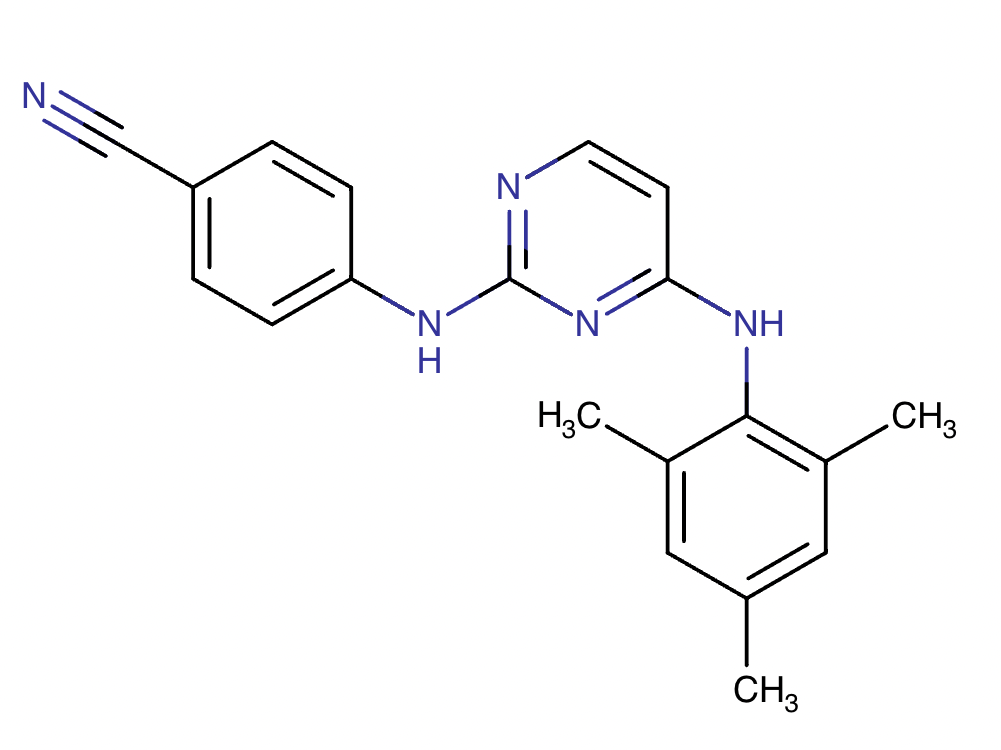
|
Developed by 

|
Supported by 

|

Dapivirine (DPV)
Developer(s)

|
Janssen Pharmaceuticals Originator
https://www.janssen.com
Belgium Janssen Pharmaceuticals is a subsidiary company of Johnson & Johnson headquartered in Beerse, Belgium. They focus on manufacturing and developing pharmaceutical products for use in areas such as, Immunology, Infectious Diseases & Vaccines, Pulmonary Hypertension, Cardiovascular & Metabolism, Oncology, and Neuroscience. |
Drug structure

Dapivirine Chemical Structure
Sourced from Drugbank
Drug information
Associated long-acting platforms
Intra-vaginal ring
Administration route
Topical (Vaginal)
Therapeutic area(s)
Use case(s)
Use of drug
Ease of administration
Frequency of administration
User acceptance
Not provided
Dosage
Available dose and strength
25 mg of dapivirine in the monthly ring
Maximum dose
25 mg
Recommended dosing regimen
Not provided
Additional comments
Not provided
Dosage link(s)
Not provided
Drug information
Drug's link(s)
Not provided
Generic name
Brand name
Compound type
Summary
Approval status
Regulatory authorities
Delivery device(s)
No delivery device
Scale-up and manufacturing prospects
Scale-up prospects
DPV is manufactured commercially through a well-defined synthetic chemical process and undergoes a micronisation procedure to improve drug dispersion within the silicon intravaginal ring. The current DPV ring formulation (Ring-004) contains 25mg of micronised drug product and is produced with NuSil™ DDU-4870 silicone elastomer using addition-curing to prevent the formation of undesirable volatile alcohol by-products. This formulation provides high pharmacokinetic exposure with low overall manufacturing costs. Novel additive manufacturing techniques (e.g. APF) could provide new formulations.
Tentative equipment list for manufacturing
For ring manufacture: Injection molding machine, mixer, automated inspection and packaging machines.
Manufacturing
Manufacturing is a non-standard four stage workflow process: (1) preparation of the master batch, (2) pre-mix formation, (3) ring construction using injection addition-curing, and (4) packaging/inspection. For DPV Compound: stability testing indicates that the chemical compound can be stored for up to 6 months at 40ºC and 96 months at 25ºC in the pre-specified commercial packaging. DPV is photo-stable. For Finished Ring Product: stability testing shows that the product can be stored for 48 months at 30ºC. The DPV ring product is photosensitive and should be stored away from light sources.
Specific analytical instrument required for characterization of formulation
For DPV Compound: HPLC (determine chemical purity), GC (residual solvents), laser diffraction (determine particle size), Karl Fischer titration (determine water content) and FT-IR & DSC (chemical identification). For Finished Ring Product: HPLC (determine dissolution, content uniformity and degradation products), compression testing machine (determine tensile and compression properties).
Clinical trials
MTN-029/IPM 039
Identifier
NCT02808949
Link
https://clinicaltrials.gov/ct2/show/NCT02808949
Phase
Phase I
Status
Completed
Sponsor
International Partnership for Microbicides, Inc.
More details
Not provided
Purpose
Evaluate the pharmacokinetic profile of the Dapivirine vaginal ring in lactating women.
Interventions
Intervention 1
Countries
Sites / Institutions
Not provided
Trials dates
Anticipated Start Date
Not provided
Actual Start Date
2015-02-01
Anticipated Date of Last Follow-up
Not provided
Estimated Primary Completion Date
Not provided
Estimated Completion Date
Not provided
Actual Primary Completion Date
2018-03-03
Actual Completion Date
2018-03-03
Studied populations
Age Cohort
- Adults
Genders
- Cisgender female
Accepts pregnant individuals
No
Accepts lactating individuals
Yes
Accepts healthy individuals
Yes
Comments about the studied populations
Women aged 18 and over who are able and willing to express breast milk twice a day or more over the duration of the drug exposure study. After initiation of the drug product, participants must not provide any subsequently expressed breast milk to their children or to others for consumption during the study.
Health status
Study type
Interventional (clinical trial)
Enrollment
16
Allocation
Not provided
Intervention model
Single group assignment
Intervention model description
Not provided
Masking
Open label
Masking description
None (Open Label)
Frequency of administration
Studied LA-formulation(s)
Studied route(s) of administration
Use case
PrEP
Key resources
| Type | Title | Content | Link |
|---|---|---|---|
| Link | Pharmacokinetics of Dapivirine Transfer into Blood Plasma, Breast Milk, and Cervicovaginal Fluid of Lactating Women Using the Dapivirine Vaginal Ring | https://doi.org/10.1128/aac.01930-18 |
IPM 035
Identifier
NCT02858024
Link
https://clinicaltrials.gov/ct2/show/NCT02858024
Phase
Phase I
Status
Completed
Sponsor
International Partnership for Microbicides, Inc.
More details
Not provided
Purpose
Evaluate the effects of tampon use and menses on the pharmacokinetics of Dapivirine vaginal ring-004 in HIV-uninfected women.
Interventions
Intervention 1
Intervention 2
Intervention 3
Intervention 4
Intervention 5
Countries
Not provided
Sites / Institutions
Not provided
Trials dates
Anticipated Start Date
Not provided
Actual Start Date
2015-01-12
Anticipated Date of Last Follow-up
Not provided
Estimated Primary Completion Date
Not provided
Estimated Completion Date
Not provided
Actual Primary Completion Date
2016-04-16
Actual Completion Date
2016-04-16
Studied populations
Age Cohort
- Adults
Genders
- Cisgender female
Accepts pregnant individuals
No
Accepts lactating individuals
No
Accepts healthy individuals
Yes
Comments about the studied populations
Women aged between 18 and ≤ 40 years.
Health status
Study type
Interventional (clinical trial)
Enrollment
16
Allocation
Randomized
Intervention model
Cross-over assignment
Intervention model description
Not provided
Masking
Open label
Masking description
None (Open Label)
Frequency of administration
Studied LA-formulation(s)
Studied route(s) of administration
Use case
PrEP
Key resources
IPM 054
Identifier
NCT05416021
Link
https://clinicaltrials.gov/ct2/show/NCT05416021
Phase
Phase I
Status
Active, not recruiting
Sponsor
International Partnership for Microbicides, Inc.
More details
Not provided
Purpose
Compare the relative bioavailability in plasma and vaginal fluid of the 25mg Dapivirine vaginal ring-004 and 100 mg Dapivirine vaginal ring-008 in HIV-uninfected women.
Interventions
Intervention 1
Countries
Sites / Institutions
Not provided
Trials dates
Anticipated Start Date
Not provided
Actual Start Date
2022-08-01
Anticipated Date of Last Follow-up
Not provided
Estimated Primary Completion Date
2024-04-01
Estimated Completion Date
2024-04-01
Actual Primary Completion Date
Not provided
Actual Completion Date
Not provided
Studied populations
Age Cohort
- Adults
Genders
- Cisgender female
Accepts pregnant individuals
No
Accepts lactating individuals
No
Accepts healthy individuals
Yes
Comments about the studied populations
Women aged 18-45 inclusive.
Health status
Study type
Interventional (clinical trial)
Enrollment
110
Allocation
Randomized
Intervention model
Cross-over assignment
Intervention model description
Not provided
Masking
Open label
Masking description
None (Open Label)
Frequency of administration
Studied LA-formulation(s)
Studied route(s) of administration
Use case
PrEP
Key resources
MTN-036/IPM-047
Identifier
NCT03234400
Link
https://clinicaltrials.gov/ct2/show/NCT03234400
Phase
Phase I
Status
Completed
Sponsor
International Partnership for Microbicides, Inc.
More details
Not provided
Purpose
Evaluate the safety and pharmacokinetics of extended duration Dapivirine vaginal rings.
Interventions
Intervention 1
Intervention 2
Intervention 3
Countries
Sites / Institutions
Not provided
Trials dates
Anticipated Start Date
Not provided
Actual Start Date
2017-12-04
Anticipated Date of Last Follow-up
Not provided
Estimated Primary Completion Date
Not provided
Estimated Completion Date
Not provided
Actual Primary Completion Date
2018-10-23
Actual Completion Date
2019-01-23
Studied populations
Age Cohort
- Adults
Genders
- Cisgender female
Accepts pregnant individuals
No
Accepts lactating individuals
No
Accepts healthy individuals
Yes
Comments about the studied populations
Women aged 18-45 inclusive.
Health status
Study type
Interventional (clinical trial)
Enrollment
49
Allocation
Randomized
Intervention model
Parallel Assignment
Intervention model description
Not provided
Masking
Single blind masking
Masking description
Single (Participant)
Frequency of administration
Studied LA-formulation(s)
Studied route(s) of administration
Use case
PrEP
Key resources
| Type | Title | Content | Link |
|---|---|---|---|
| Link | Phase 1 pharmacokinetics and safety study of extended duration dapivirine vaginal rings in the United States | https://doi.org/10.1002/jia2.25747 | |
| Link | Users' Preferred Characteristics of Vaginal Rings for HIV Prevention: A Qualitative Analysis of Two Phase I Trials | https://doi.org/10.1089/aid.2021.0077 |
DREAM
Identifier
NCT02862171
Link
https://clinicaltrials.gov/ct2/show/NCT02862171
Phase
Phase III
Status
Completed
Sponsor
International Partnership for Microbicides, Inc.
More details
Not provided
Purpose
A follow-on, open label trial to assess patient adherence and continued safety of the 25mg Dapivirine vaginal ring-004 in HIV-negative women.
Interventions
Intervention 1
Countries
Sites / Institutions
Not provided
Trials dates
Anticipated Start Date
Not provided
Actual Start Date
2016-07-12
Anticipated Date of Last Follow-up
Not provided
Estimated Primary Completion Date
Not provided
Estimated Completion Date
Not provided
Actual Primary Completion Date
2019-01-11
Actual Completion Date
2019-01-11
Studied populations
Age Cohort
- Adults
Genders
- Cisgender female
Accepts pregnant individuals
No
Accepts lactating individuals
No
Accepts healthy individuals
Yes
Comments about the studied populations
Participants are required to be previously enrolled in the IPM 027 trial.
Health status
Study type
Interventional (clinical trial)
Enrollment
941
Allocation
Not provided
Intervention model
Single group assignment
Intervention model description
Not provided
Masking
Open label
Masking description
None (Open Label)
Frequency of administration
Studied LA-formulation(s)
Studied route(s) of administration
Use case
PrEP
Key resources
| Type | Title | Content | Link |
|---|---|---|---|
| Link | Safety, adherence, and HIV-1 seroconversion among women using the dapivirine vaginal ring (DREAM): an open-label, extension study | https://doi.org/10.1016/S2352-3018(20)30300-3 |
MTN-024/IPM031
Identifier
NCT02010593
Link
https://clinicaltrials.gov/ct2/show/NCT02010593
Phase
Phase II
Status
Completed
Sponsor
International Partnership for Microbicides, Inc.
More details
Not provided
Purpose
Evaluate the safety of the Dapivirine vaginal ring when administered once every 28 days for twelve weeks in postmenopausal women.
Interventions
Intervention 1
Intervention 2
Countries
Sites / Institutions
Not provided
Trials dates
Anticipated Start Date
Not provided
Actual Start Date
2013-12-01
Anticipated Date of Last Follow-up
Not provided
Estimated Primary Completion Date
Not provided
Estimated Completion Date
Not provided
Actual Primary Completion Date
2015-04-01
Actual Completion Date
2015-04-01
Studied populations
Age Cohort
- Adults
- Older Adults
Genders
- Cisgender female
Accepts pregnant individuals
No
Accepts lactating individuals
No
Accepts healthy individuals
Yes
Comments about the studied populations
Women aged 45-65 inclusive.
Health status
Study type
Interventional (clinical trial)
Enrollment
96
Allocation
Randomized
Intervention model
Parallel Assignment
Intervention model description
Not provided
Masking
Double-blind masking
Masking description
Double (Participant, Investigator)
Frequency of administration
Studied LA-formulation(s)
Studied route(s) of administration
Use case
PrEP
Key resources
| Type | Title | Content | Link |
|---|---|---|---|
| Link | Acceptability of the Dapivirine Vaginal Ring in Postmenopausal US Women | https://doi.org/10.1089/apc.2022.0002 | |
| Link | Phase 2a Safety, Pharmacokinetics, and Acceptability of Dapivirine Vaginal Rings in US Postmenopausal Women | https://doi.org/10.1093/cid/ciy654 |
ASPIRE
Identifier
NCT01617096
Link
https://clinicaltrials.gov/ct2/show/NCT01617096
Phase
Phase III
Status
Completed
Sponsor
International Partnership for Microbicides, Inc.
More details
Not provided
Purpose
Evaluate the effectiveness and safety of the Dapivirine vaginal ring in preventing HIV-1 infection in women at high risk of acquiring HIV-1.
Interventions
Intervention 1
Intervention 2
Countries
Sites / Institutions
Not provided
Trials dates
Anticipated Start Date
Not provided
Actual Start Date
2012-07-24
Anticipated Date of Last Follow-up
Not provided
Estimated Primary Completion Date
Not provided
Estimated Completion Date
Not provided
Actual Primary Completion Date
2015-07-03
Actual Completion Date
2015-12-01
Studied populations
Age Cohort
- Adults
Genders
- Cisgender female
Accepts pregnant individuals
No
Accepts lactating individuals
No
Accepts healthy individuals
Yes
Comments about the studied populations
Women aged 18-45 years inclusive.
Health status
Study type
Interventional (clinical trial)
Enrollment
2629
Allocation
Randomized
Intervention model
Parallel Assignment
Intervention model description
Not provided
Masking
Double-blind masking
Masking description
Double (Participant, Investigator)
Frequency of administration
Studied LA-formulation(s)
Studied route(s) of administration
Use case
PrEP
Key resources
| Type | Title | Content | Link |
|---|---|---|---|
| Link | Patterns of Adherence to a Dapivirine Vaginal Ring for HIV-1 Prevention Among South African Women in a Phase III Randomized Controlled Trial | https://doi.org/10.1097/qai.0000000000002990 | |
| Link | Experiences with simultaneous use of contraception and the vaginal ring for HIV prevention in sub-Saharan Africa | https://doi.org/10.1186/s12905-021-01321-5 | |
| Link | Acceptability of the Dapivirine Vaginal Ring for HIV-1 Prevention and Association with Adherence in a Phase III Trial | https://doi.org/10.1007/s10461-021-03205-z | |
| Link | Risk of HIV-1 acquisition among South African women using a variety of contraceptive methods in a prospective study | https://doi.org/10.1097/qad.0000000000002260 | |
| Link | Acquisition of Sexually Transmitted Infections among Women Using a Variety of Contraceptive Options: A prospective Study among High-risk African Women | https://doi.org/10.1002/jia2.25257 | |
| Link | Clinical and Virologic Outcomes Following Initiation of Antiretroviral Therapy Among Seroconverters in the Microbicide Trials Network-020 Phase III Trial of the Dapivirine Vaginal Ring | https://doi.org/10.1093/cid/ciy909 | |
| Link | Vaginal Ring Use in a Phase 3 Microbicide Trial: A Comparison of Objective Measures and Self-reports of Non-adherence in ASPIRE | https://doi.org/10.1007/s10461-018-2261-8 | |
| Link | Use of a Vaginal Ring Containing Dapivirine for HIV-1 Prevention in Women | https://doi.org/10.1056/nejmoa1506110 |
MTN-034
Identifier
NCT03593655
Link
https://clinicaltrials.gov/ct2/show/NCT03593655
Phase
Phase II
Status
Completed
Sponsor
National Institute of Allergy and Infectious Diseases (NIAID)
More details
Not provided
Purpose
Evaluate the adherence and safety of a Dapivirine vaginal ring with oral emtricitabine/tenofovir disoproxil fumarate (FTC/TDF) in adolescent and young adult females.
Interventions
Intervention 1
Intervention 2
Countries
Sites / Institutions
Not provided
Trials dates
Anticipated Start Date
Not provided
Actual Start Date
2019-01-14
Anticipated Date of Last Follow-up
Not provided
Estimated Primary Completion Date
Not provided
Estimated Completion Date
Not provided
Actual Primary Completion Date
2021-09-09
Actual Completion Date
2021-09-09
Studied populations
Age Cohort
- Adolescents
- Adults
Genders
- Cisgender female
Accepts pregnant individuals
No
Accepts lactating individuals
No
Accepts healthy individuals
Yes
Comments about the studied populations
Women aged 16-21 inclusive.
Health status
Study type
Interventional (clinical trial)
Enrollment
247
Allocation
Randomized
Intervention model
Cross-over assignment
Intervention model description
Not provided
Masking
Open label
Masking description
None (Open Label)
Frequency of administration
Studied LA-formulation(s)
Studied route(s) of administration
Use case
PrEP
Key resources
HOPE
Identifier
NCT02858037
Link
https://clinicaltrials.gov/ct2/show/NCT02858037
Phase
Phase III
Status
Completed
Sponsor
International Partnership for Microbicides, Inc.
More details
Not provided
Purpose
A follow-on, open label trial to assess adherence to and the continued safety of a Dapivirine vaginal ring in HIV-uninfected women.
Interventions
Intervention 1
Countries
Sites / Institutions
Not provided
Trials dates
Anticipated Start Date
Not provided
Actual Start Date
2016-07-18
Anticipated Date of Last Follow-up
Not provided
Estimated Primary Completion Date
Not provided
Estimated Completion Date
Not provided
Actual Primary Completion Date
2018-10-10
Actual Completion Date
2018-10-10
Studied populations
Age Cohort
- Adults
Genders
- Cisgender female
Accepts pregnant individuals
No
Accepts lactating individuals
No
Accepts healthy individuals
Yes
Comments about the studied populations
Women aged 18-40 previously enrolled in MTN-020 (ASPIRE).
Health status
Study type
Interventional (clinical trial)
Enrollment
1456
Allocation
Not provided
Intervention model
Single group assignment
Intervention model description
Participants will receive a silicone elastomer vaginal matrix ring containing 25 mg of Dapivirine to be replaced each month for a total period of 12 months of use.
Masking
Open label
Masking description
None (Open Label)
Frequency of administration
Studied LA-formulation(s)
Studied route(s) of administration
Use case
PrEP
Key resources
| Type | Title | Content | Link |
|---|---|---|---|
| Link | Safety, uptake, and use of a dapivirine vaginal ring for HIV-1 prevention in African women (HOPE): an open-label, extension study | https://doi.org/10.1016/s2352-3018(20)30304-0 | |
| Link | Sharing Objective Measures of Adherence to a Vaginal Microbicide Promotes Candor About Actual Use and Bolsters Motivation to Prevent HIV | https://doi.org/10.1007/s10461-020-03026-6 |
MTN-042
Identifier
NCT03965923
Link
https://clinicaltrials.gov/ct2/show/NCT03965923
Phase
Phase III
Status
Active, not recruiting
Sponsor
National Institute of Allergy and Infectious Diseases (NIAID)
More details
Not provided
Purpose
Evaluate infant and maternal safety of the Dapivirine vaginal ring and daily oral Truvada in HIV-uninfected pregnant women.
Interventions
Intervention 1
Intervention 2
Countries
Sites / Institutions
Not provided
Trials dates
Anticipated Start Date
Not provided
Actual Start Date
2020-01-09
Anticipated Date of Last Follow-up
Not provided
Estimated Primary Completion Date
2024-06-30
Estimated Completion Date
2024-06-30
Actual Primary Completion Date
Not provided
Actual Completion Date
Not provided
Studied populations
Age Cohort
- Adults
Genders
- Cisgender female
Accepts pregnant individuals
Yes
Accepts lactating individuals
No
Accepts healthy individuals
Yes
Comments about the studied populations
Women aged 18-40 years inclusive.
Health status
Study type
Interventional (clinical trial)
Enrollment
Not provided
Allocation
Randomized
Intervention model
Sequential assignment
Intervention model description
Not provided
Masking
Open label
Masking description
None (Open Label)
Frequency of administration
Studied LA-formulation(s)
Studied route(s) of administration
Use case
PrEP
Key resources
IPM 024
Identifier
NCT02920827
Link
https://clinicaltrials.gov/ct2/show/NCT02920827
Phase
Phase I
Status
Completed
Sponsor
International Partnership for Microbicides, Inc.
More details
Not provided
Purpose
Evaluate the tolerability and safety of the dapivirine ring as compared to a placebo ring when inserted for four weeks in HIV-uninfected women.
Interventions
Intervention 1
Intervention 2
Countries
Sites / Institutions
Not provided
Trials dates
Anticipated Start Date
Not provided
Actual Start Date
2009-08-01
Anticipated Date of Last Follow-up
Not provided
Estimated Primary Completion Date
Not provided
Estimated Completion Date
Not provided
Actual Primary Completion Date
2010-04-01
Actual Completion Date
2010-04-01
Studied populations
Age Cohort
- Adults
Genders
- Cisgender female
Accepts pregnant individuals
No
Accepts lactating individuals
No
Accepts healthy individuals
Yes
Comments about the studied populations
Women aged 18-40 years inclusive.
Health status
Study type
Interventional (clinical trial)
Enrollment
16
Allocation
Randomized
Intervention model
Parallel Assignment
Intervention model description
Not provided
Masking
Double-blind masking
Masking description
Double (Participant, Investigator)
Frequency of administration
Studied LA-formulation(s)
Studied route(s) of administration
Use case
PrEP
Key resources
IPM 027
Identifier
NCT01539226
Link
https://clinicaltrials.gov/ct2/show/NCT01539226
Phase
Phase III
Status
Completed
Sponsor
International Partnership for Microbicides, Inc.
More details
Not provided
Purpose
Evalute the efficacy and safety of a Dapivirine vaginal matrix ring in healthy HIV-uninfected women.
Interventions
Intervention 1
Intervention 2
Countries
Sites / Institutions
Not provided
Trials dates
Anticipated Start Date
Not provided
Actual Start Date
2012-03-27
Anticipated Date of Last Follow-up
Not provided
Estimated Primary Completion Date
Not provided
Estimated Completion Date
Not provided
Actual Primary Completion Date
2016-12-13
Actual Completion Date
2016-12-13
Studied populations
Age Cohort
- Adults
Genders
- Cisgender female
Accepts pregnant individuals
No
Accepts lactating individuals
No
Accepts healthy individuals
Yes
Comments about the studied populations
Women participants aged 18-45.
Health status
Study type
Interventional (clinical trial)
Enrollment
1959
Allocation
Randomized
Intervention model
Parallel Assignment
Intervention model description
Not provided
Masking
Double-blind masking
Masking description
Double (Participant, Investigator)
Frequency of administration
Studied LA-formulation(s)
Studied route(s) of administration
Use case
PrEP
Key resources
| Type | Title | Content | Link |
|---|---|---|---|
| Link | Safety and Efficacy of a Dapivirine Vaginal Ring for HIV Prevention in Women | https://doi.org/10.1056/nejmoa1602046 | |
| Link | Assessment of risk compensation following use of the dapivirine vaginal ring in southwestern Uganda | https://doi.org/10.1136/sextrans-2020-054718 |
MTN-023/IPM 030
Identifier
NCT02028338
Link
https://clinicaltrials.gov/ct2/show/NCT02028338
Phase
Phase II
Status
Completed
Sponsor
International Partnership for Microbicides, Inc.
More details
Not provided
Purpose
Evalute the safety of a 25mg dapivirine vaginal ring in HIV-uninfected adolescent females, when inserted once every 28 days for 24-weeks.
Interventions
Intervention 1
Intervention 2
Countries
Sites / Institutions
Not provided
Trials dates
Anticipated Start Date
Not provided
Actual Start Date
2014-07-27
Anticipated Date of Last Follow-up
Not provided
Estimated Primary Completion Date
Not provided
Estimated Completion Date
Not provided
Actual Primary Completion Date
2016-07-05
Actual Completion Date
2018-06-08
Studied populations
Age Cohort
- Adolescents
Genders
- Cisgender female
Accepts pregnant individuals
No
Accepts lactating individuals
No
Accepts healthy individuals
Unspecified
Comments about the studied populations
Participants aged 15-17 inclusive at enrollment.
Health status
Study type
Interventional (clinical trial)
Enrollment
96
Allocation
Randomized
Intervention model
Parallel Assignment
Intervention model description
Not provided
Masking
Quadruple-blind masking
Masking description
Quadruple (Participant, Care Provider, Investigator, Outcomes Assessor)
Frequency of administration
Studied LA-formulation(s)
Studied route(s) of administration
Use case
PrEP
Key resources
| Type | Title | Content | Link |
|---|---|---|---|
| Link | Outline Images Download Cite Share Favorites Permissions PREVENTION RESEARCH Brief Report: Phase IIa Safety Study of a Vaginal Ring Containing Dapivirine in Adolescent Young Women | https://doi.org/10.1097/qai.0000000000002244 |
IPM 015
Identifier
NCT01071174
Link
https://clinicaltrials.gov/ct2/show/NCT01071174
Phase
Phase I/II
Status
Completed
Sponsor
International Partnership for Microbicides, Inc.
More details
Not provided
Purpose
Evaluate the safety profile of a Dapivirine intravaginal matrix ring in HIV-uninfected women.
Interventions
Intervention 1
Intervention 2
Countries
Sites / Institutions
Not provided
Trials dates
Anticipated Start Date
Not provided
Actual Start Date
2010-04-01
Anticipated Date of Last Follow-up
Not provided
Estimated Primary Completion Date
Not provided
Estimated Completion Date
Not provided
Actual Primary Completion Date
2011-05-01
Actual Completion Date
2011-07-01
Studied populations
Age Cohort
- Adults
Genders
- Cisgender female
Accepts pregnant individuals
No
Accepts lactating individuals
No
Accepts healthy individuals
Yes
Comments about the studied populations
Women aged between 18-45 years inclusive.
Health status
Study type
Interventional (clinical trial)
Enrollment
280
Allocation
Randomized
Intervention model
Parallel Assignment
Intervention model description
Not provided
Masking
Triple-blind masking
Masking description
Triple (Participant, Care Provider, Investigator)
Frequency of administration
Studied LA-formulation(s)
Studied route(s) of administration
Use case
PrEP
Key resources
IPM 034
Identifier
NCT01952561
Link
https://clinicaltrials.gov/ct2/show/NCT01952561
Phase
Phase I
Status
Completed
Sponsor
International Partnership for Microbicides, Inc.
More details
Not provided
Purpose
Evaluate the blood and vaginal pharmacokinetics of a 25mg Dapivirine vaginal ring worn for 1, 2, 4, 8 or 12 months.
Interventions
Intervention 1
Countries
Not provided
Sites / Institutions
Not provided
Trials dates
Anticipated Start Date
Not provided
Actual Start Date
2013-11-01
Anticipated Date of Last Follow-up
Not provided
Estimated Primary Completion Date
Not provided
Estimated Completion Date
Not provided
Actual Primary Completion Date
2014-03-01
Actual Completion Date
2014-05-01
Studied populations
Age Cohort
- Adults
Genders
- Cisgender female
Accepts pregnant individuals
No
Accepts lactating individuals
No
Accepts healthy individuals
Yes
Comments about the studied populations
Women between 18-40 years of age.
Health status
Study type
Interventional (clinical trial)
Enrollment
40
Allocation
Randomized
Intervention model
Parallel Assignment
Intervention model description
Not provided
Masking
Open label
Masking description
None (Open Label)
Frequency of administration
Studied LA-formulation(s)
Studied route(s) of administration
Use case
PrEP
Key resources
IPM 009B
Identifier
NCT01337583
Link
https://clinicaltrials.gov/ct2/show/NCT01337583
Phase
Phase III
Status
Withdrawn
Sponsor
International Partnership for Microbicides, Inc.
More details
Not provided
Purpose
Evaluate the efficacy and safety of a Dapivirine vaginal matrix ring for HIV-1 PrEP in women.
Interventions
Intervention 1
Intervention 2
Countries
Sites / Institutions
Not provided
Trials dates
Anticipated Start Date
Not provided
Actual Start Date
2011-07-01
Anticipated Date of Last Follow-up
Not provided
Estimated Primary Completion Date
Not provided
Estimated Completion Date
Not provided
Actual Primary Completion Date
2014-07-01
Actual Completion Date
2014-07-01
Studied populations
Age Cohort
- Adults
Genders
- Cisgender female
Accepts pregnant individuals
No
Accepts lactating individuals
No
Accepts healthy individuals
Yes
Comments about the studied populations
Women aged between 18-40 years.
Health status
Study type
Interventional (clinical trial)
Enrollment
Not provided
Allocation
Randomized
Intervention model
Parallel Assignment
Intervention model description
Not provided
Masking
Double-blind masking
Masking description
Double (Participant, Investigator)
Frequency of administration
Studied LA-formulation(s)
Studied route(s) of administration
Use case
PrEP
Key resources
IPM 018
Identifier
NCT00469768
Link
https://clinicaltrials.gov/ct2/show/NCT00469768
Phase
Phase I
Status
Completed
Sponsor
International Partnership for Microbicides, Inc.
More details
Not provided
Purpose
Evaluate the pharmacokinetics and safety of a 25 mg of Dapivirine intravaginal ring in HIV-uninfected women to determine the release of Dapivirine from the reservoir and matrix.
Interventions
Intervention 1
Intervention 2
Intervention 3
Countries
Sites / Institutions
Not provided
Trials dates
Anticipated Start Date
Not provided
Actual Start Date
2007-05-01
Anticipated Date of Last Follow-up
Not provided
Estimated Primary Completion Date
Not provided
Estimated Completion Date
Not provided
Actual Primary Completion Date
2007-08-01
Actual Completion Date
2007-08-01
Studied populations
Age Cohort
- Adults
Genders
- Cisgender female
Accepts pregnant individuals
No
Accepts lactating individuals
No
Accepts healthy individuals
Yes
Comments about the studied populations
Women aged between 18-35 years.
Health status
Study type
Interventional (clinical trial)
Enrollment
24
Allocation
Randomized
Intervention model
Parallel Assignment
Intervention model description
Not provided
Masking
Double-blind masking
Masking description
Double (Participant, Investigator)
Frequency of administration
Studied LA-formulation(s)
Studied route(s) of administration
Use case
PrEP
Key resources
IPM 013
Identifier
NCT01144676
Link
https://clinicaltrials.gov/ct2/show/NCT01144676
Phase
Phase I
Status
Completed
Sponsor
International Partnership for Microbicides, Inc.
More details
Not provided
Purpose
Evaluate the delivery of dapivirine from matrix intravaginal rings to assess the safety in comparison to placebo intravaginal rings in HIV-uninfected sexually active women.
Interventions
Intervention 1
Intervention 2
Countries
Sites / Institutions
Not provided
Trials dates
Anticipated Start Date
Not provided
Actual Start Date
2010-04-01
Anticipated Date of Last Follow-up
Not provided
Estimated Primary Completion Date
Not provided
Estimated Completion Date
Not provided
Actual Primary Completion Date
2010-09-01
Actual Completion Date
2010-09-01
Studied populations
Age Cohort
- Adults
Genders
- Cisgender female
Accepts pregnant individuals
No
Accepts lactating individuals
No
Accepts healthy individuals
Yes
Comments about the studied populations
Women aged between 18-40 years.
Health status
Study type
Interventional (clinical trial)
Enrollment
45
Allocation
Randomized
Intervention model
Parallel Assignment
Intervention model description
Not provided
Masking
Double-blind masking
Masking description
Double (Participant, Investigator)
Frequency of administration
Studied LA-formulation(s)
Studied route(s) of administration
Use case
PrEP
Key resources
IPM 001
Identifier
NCT00700284
Link
https://clinicaltrials.gov/ct2/show/NCT00700284
Phase
Phase I
Status
Completed
Sponsor
International Partnership for Microbicides, Inc.
More details
Not provided
Purpose
Evaluate the feasibility, safety and tolerability of utilising a vaginal ring delivery system to administer TMC120 (dapivirine).
Interventions
Intervention 1
Intervention 2
Countries
Sites / Institutions
Not provided
Trials dates
Anticipated Start Date
Not provided
Actual Start Date
2004-10-01
Anticipated Date of Last Follow-up
Not provided
Estimated Primary Completion Date
Not provided
Estimated Completion Date
Not provided
Actual Primary Completion Date
2005-01-01
Actual Completion Date
2005-01-01
Studied populations
Age Cohort
- Adults
Genders
- Cisgender female
Accepts pregnant individuals
No
Accepts lactating individuals
No
Accepts healthy individuals
Yes
Comments about the studied populations
Women aged between 18-50 years.
Health status
Study type
Interventional (clinical trial)
Enrollment
12
Allocation
Non-randomized
Intervention model
Cross-over assignment
Intervention model description
Not provided
Masking
Open label
Masking description
None (Open Label)
Frequency of administration
Studied LA-formulation(s)
Studied route(s) of administration
Use case
PrEP
Key resources
IPM 008
Identifier
NCT00332995
Link
https://clinicaltrials.gov/ct2/show/NCT00332995
Phase
Phase I
Status
Completed
Sponsor
International Partnership for Microbicides, Inc.
More details
Not provided
Purpose
Evaluate the systemic availability, safety and tolerability of a vaginal ring for the delivery of TMC120 (dapivirine).
Interventions
Intervention 1
Countries
Sites / Institutions
Not provided
Trials dates
Anticipated Start Date
Not provided
Actual Start Date
2005-07-01
Anticipated Date of Last Follow-up
Not provided
Estimated Primary Completion Date
Not provided
Estimated Completion Date
Not provided
Actual Primary Completion Date
2005-08-01
Actual Completion Date
2005-08-01
Studied populations
Age Cohort
- Adults
Genders
- Cisgender female
Accepts pregnant individuals
No
Accepts lactating individuals
No
Accepts healthy individuals
Yes
Comments about the studied populations
Women aged 18-50 years.
Health status
Study type
Interventional (clinical trial)
Enrollment
13
Allocation
Randomized
Intervention model
Parallel Assignment
Intervention model description
Not provided
Masking
Double-blind masking
Masking description
Not provided
Frequency of administration
Studied LA-formulation(s)
Studied route(s) of administration
Use case
PrEP
Key resources
Excipients
Proprietary excipients used
DDU-4870 is a silicon elastomer product manufactured by NuSil™ Technology Inc. (Carpinteria, CA, USA). In 2016, NuSil Technology, Inc. merged with Avantor.
Novel excipients or existing excipients at a concentration above Inactive Ingredients Database (IID) for the specified route of administration
The novel excipient DDU-4870 is used in the final Ring-004 product formulation. DDU-4870 is contained and packaged within food-grade certified polyethylene pails, which have no effect on excipient quality. At room temperature (25ºC) DDU-4870 is estimated to maintain chemical stability for 12 months.
Residual solvents used
No residual solvent used
Patent info
Compound patent families
Patent informations
| Patent description | Representative patent | Categories | Patent holder | Licence with MPP | Patent source |
|---|---|---|---|---|---|
|
Dapivirine and analogues topical use for the prevention of HIV infection
Expiry date: 2023-05-13 The invention concerns the microbicidal activity of certain pyrimidine or triazine containing non-nucleoside reverse transcriptase inhibitors. The compounds of the present invention inhibit the systemic infection of a human being with HIV, in particular, the present compounds prevent sexual HIV transmission in humans. |
WO03094920 | Composition, Use | TIBOTEC PHARM LTD | No |
Patent status
| Patent status/countries | Low, Low- middle and upper-middle | High income |
|---|---|---|
| Granted | Belgium, Germany, France, Luxembourg, Netherlands, Switzerland, Sweden, Italy, Liechtenstein, Greece, Denmark, Finland, Estonia, Hungary, Latvia, Israel, Korea, Republic of, Poland, United States of America, Singapore | |
| Filed | Cyprus | |
| Not in force | Türkiye, North Macedonia, Albania, Botswana, Gambia (the), Ghana, Kenya, Lesotho, Malawi, Mozambique, Sierra Leone, Sudan, Eswatini, Tanzania, United Republic of, Uganda, Zambia, Zimbabwe, Argentina, Brazil, China, Turkmenistan, Belarus, Tajikistan, Kazakhstan, Azerbaijan, Kyrgyzstan, Armenia, Moldova, Republic of, Mexico, South Africa, India, Indonesia, Philippines, Thailand, Viet Nam, Benin, Cameroon, Burkina Faso, Chad, Guinea-Bissau, Mali, Senegal, Congo, Guinea, Gabon, Niger, Equatorial Guinea, Mauritania, Togo, Côte d'Ivoire, Central African Republic, World Intellectual Property Organization (WIPO) | Germany, United Kingdom, Austria, Spain, Monaco, Portugal, Ireland, Bulgaria, Czechia, Slovakia, Romania, Lithuania, Slovenia, Australia, Canada, Russian Federation, Hong Kong, Croatia, Japan, Norway, New Zealand, United States of America, World Intellectual Property Organization (WIPO) |
Patent informations
| Patent description | Representative patent | Categories | Patent holder | Licence with MPP | Patent source |
|---|---|---|---|---|---|
|
Dapivirine compounds and analogues (Markush structure)
Expiry date: 2019-03-24 The invention is concerned with pyrimidine derivatives having HIV replication inhibiting properties. The invention further relates to methods for their preparation and pharmaceutical compositions comprising them. The invention also relates to the use of said compounds in the manufacture of a medicament useful for the treatment of subjects suffering from HIV (Human Immunodeficiency Virus) infection |
WO9950250 | Compound | JANSSEN PHARMACEUTICA NV | No |
Patent status
| Patent status/countries | Low, Low- middle and upper-middle | High income |
|---|---|---|
| Granted | United States of America | |
| Filed | Hungary | |
| Not in force | North Macedonia, Albania, Botswana, Gambia (the), Ghana, Kenya, Lesotho, Malawi, Sierra Leone, Sudan, Eswatini, Uganda, Zambia, Zimbabwe, Argentina, Brazil, China, Turkmenistan, Belarus, Tajikistan, Kazakhstan, Azerbaijan, Kyrgyzstan, Armenia, Moldova, Republic of, Indonesia, Benin, Cameroon, Burkina Faso, Chad, Guinea-Bissau, Mali, Senegal, Congo, Guinea, Gabon, Niger, Mauritania, Togo, Côte d'Ivoire, Central African Republic, Türkiye, Ukraine, South Africa, Mexico, Viet Nam, Philippines, World Intellectual Property Organization (WIPO), Malaysia | Belgium, Germany, France, Luxembourg, Netherlands, Switzerland, United Kingdom, Sweden, Italy, Austria, Liechtenstein, Greece, Spain, Denmark, Monaco, Portugal, Ireland, Finland, Cyprus, Romania, Latvia, Lithuania, Slovenia, Australia, Bulgaria, Canada, Czechia, Russian Federation, Estonia, Hong Kong, Croatia, Hungary, Israel, Japan, Korea, Republic of, Norway, New Zealand, Poland, Slovakia, Taiwan, Province of China, United States of America, Singapore, World Intellectual Property Organization (WIPO) |
Supporting material
Publications
Welsh, N. R., Malcolm, R. K., Devlin, B., & Boyd, P. (2019). Dapivirine-releasing vaginal rings produced by plastic freeforming additive manufacturing. International Journal of Pharmaceutics. https://doi.org/10.1016/j.ijpharm.2019.118725
Here we report the first use of an additive manufacturing (AM) technique based on high pressure material jetting of molten thermoplastic for the fabrication of dapivirine (DPV) loaded vaginal rings (VRs). The VRs are compared to those produced conventionally using injection molding (IM). VRs (outer diameter 54.0 mm, cross-sectional diameter 4.0 mm) were manufactured by either injection molding or Arburg Plastic Freeforming (APF) - a proprietary droplet deposition modelling (DDM) process, using medical grade thermoplastic polyurethanes (TPUs) loaded with 10% w/w DPV. This unique DDM process was used to produce rings of 100, 50 and 10% matrix infill density. DDM printed VRs with 10% density (57-62 mg drug load) exhibited up to seven-fold increase in DPV release compared to injection molded rings containing 190-194 mg DPV. This work has shown that DDM using the APF technique can be used to manufacture drug delivery devices of varying geometries, densities and surface areas to give precise levels of control over the drug release kinetics. This work presents a new opportunity to increase the release of poorly watersoluble compounds or to achieve desired dosing levels using lower drug loadings than those required using conventional thermoplastic processing techniques.
Malcolm RK, Woolfson AD, Toner CF, Morrow RJ, McCullagh SD. Long-term, controlled release of the HIV microbicide TMC120 from silicone elastomer vaginal rings. J Antimicrob Chemother. 2005 Nov;56(5):954-6. www.doi.org/10.1093/jac/dki326. Epub 2005 Sep 9. PMID: 16155060.
Objectives: The feasibility of providing prolonged and controlled release of the experimental non-nucleoside reverse transcriptase inhibitor TMC120 from a silicone vaginal ring in quantities sufficient to maintain a vaginal concentration offering protection against heterosexual HIV transmission was investigated.
Methods: Core-type, silicone elastomer vaginal rings containing TMC120 were manufactured, and in vitro release studies performed under sink conditions. The experimental release data, as determined by HPLC, were correlated with estimates of vaginal TMC120 concentrations required to inhibit HIV replication.
Results: Continuous, zero-order release of TMC120 from core-type vaginal rings was observed in vitro over a 71 day period, equivalent to 136 μg/day. The release rate is predicted to maintain vaginal concentrations of the antiretroviral in the range of several orders of magnitude in excess of reported HIV inhibitory concentration values.
Conclusions: Continuous and prolonged zero-order release of TMC120 from a silicone vaginal ring device at quantities predicted to prevent HIV infection was observed.
Diarylaniline Derivatives as a Distinct Class of HIV-1 Non-nucleoside Reverse Transcriptase Inhibitors. Bingjie Qin, Xingkai Jiang, Hong Lu, Xingtao Tian, Florent Barbault, Li Huang, Keduo Qian, Chin-Ho Chen, Rong Huang, Shibo Jiang, Kuo-Hsiung Lee, and Lan Xie. Journal of Medicinal Chemistry, 2010, 53 (13), 4906-4916. www.doi.org/10.1021/jm1002952
By using structure-based drug design and isosteric replacement, diarylaniline and 1,5-diarylbenzene-1,2-diamine derivatives were synthesized and evaluated against wild type HIV-1 and drug-resistant viral strains, resulting in the discovery of diarylaniline derivatives as a distinct class of next-generation HIV-1 non-nucleoside reverse transcriptase inhibitor (NNRTI) agents. The most promising compound 37 showed significant EC50 values of 0.003−0.032 μM against HIV-1 wild-type strains and of 0.005−0.604 μM against several drug-resistant strains. Current results also revealed important structure−activity relationship (SAR) conclusions for diarylanilines and strongly support our hypothesis that an NH2 group on the central benzene ring ortho to the aniline moiety is crucial for interaction with K101 of the NNRTI binding site in HIV-1 RT, likely by forming H-bonds with K101. Furthermore, molecular modeling studies with molecular mechanism/general Born surface area (MM/GBSA) technology demonstrated the rationality of our hypothesis.
Additional documents
No documents were uploaded
Useful links
Access principles
|
|
Collaborate for developmentConsider on a case by case basis, collaborating on developing long acting products with potential significant public health impact, especially for low- and middle-income countries (LMICs), utilising the referred to long-acting technology Not provided |
|
|
Share technical information for match-making assessmentProvide necessary technical information to a potential partner, under confidentiality agreement, to enable preliminary assessment of whether specific medicines of public health importance in LMICs might be compatible with the referred to long-acting technology to achieve a public health benefit Not provided |
|
|
Work with MPP to expand access in LMICsIn the event that a product using the referred to long-acting technology is successfully developed, the technology IP holder(s) will work with the Medicines Patent Pool towards putting in place the most appropriate strategy for timely and affordable access in low and middle-income countries, including through licensing Not provided |
Comment & Information
Not provided